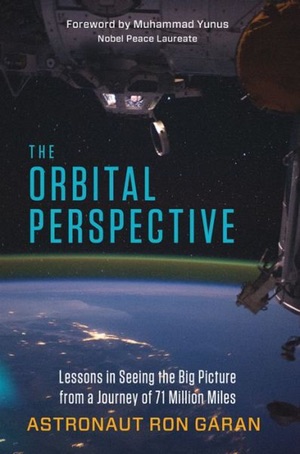Review: The Orbital Perspectiveby Jeff Foust
|
| “I would like to tell you that when I went to space I had an epiphany, that I looked at the Earth from space and was filled with an instant realization and given an orbital perspective,” he writes. “But it didn’t really happen that way.” |
Those interested in the latter—his time in space—can find some discussion of it in the second part of the three-part book. He describes his first trip to space as a member of the STS-124 shuttle crew, installing the Kibo module on the ISS in 2008. He also discusses, although in less detail, the five and a half months he spent on the station in 2011. But this book is no astronaut memoir: he does not discuss in great detail either mission, or his career leading up to becoming an astronaut and being selected for those flights.
It’s in that section, though, that he discusses what he called the Orbital Perspective. It is based on the Overview Effect, but also includes something he calls “elevated empathy.” He said he experienced that elevated empathy when he photographed something from the ISS he thought was a river reflecting moonlight, but was instead the illuminated border between India and Pakistan. “This scar on the otherwise beautiful landscape was a compelling call to focus on the need for global collaboration to overcome the world’s problems,” he writes.
Much of the book is his desire for more effective global collaboration. The first part of the book is primarily a case study of how Americans and Russians learned to work together more effectively, overcoming language and cultural barriers, in the early years of the ISS. (This part is largely a second-hand account by Garan, since he didn’t join NASA until 2000.) The last part is a discussion of varying ways to better accomplish that collaboration, with a particular emphasis on those that involve NASA, like the International Space Apps Challenge.
Creating better collaboration to solve problems on Earth doesn’t require flying into space or experiencing the Overview Effect, Garan argues. “I would like to tell you that when I went to space I had an epiphany, that I looked at the Earth from space and was filled with an instant realization and given an orbital perspective,” he writes. “But it didn’t really happen that way. Before I ever launched into space, I already had a theoretical understanding of the orbital perspective. Going to space only confirmed what I already knew.”
And, he continues, you don’t have to go into space to experience that change of perspective. “Adopting an orbital perspective simply involves incorporation of a big picture and long-term awareness of the full effects of the decisions we make, and an ability to put yourself into another’s shoes.”
That may explain why the Overview Effect, widely trumpeted by many in the space community as a transformative experience, may not be influential as they believe. Garan was already primed, in many respects, to use his spaceflights as a catalyst for becoming an advocate for collaboration on Earth. Several years before his first spaceflight, he established a non-profit organization to promote renewable energy, and visited Rwanda as part of trip organized by his foundation and a group called Engineers Without Borders. Going into space only crystallized a viewpoint—that Orbital Perspective—that he was already forming with his terrestrial experience alone.
| That may explain why the Overview Effect, widely trumpeted by many in the space community as a transformative experience, may not be influential as they believe. |
While many may say they were moved by the experience of seeing the Earth from space, few have radically acted upon that experience after returning to Earth. And one person who has—Garan left NASA in 2013 to work on his various projects, like the Fragile Oasis project—was already strongly inclined to do such work prior to going into space. But if Garan’s Orbital Perspective can be achieved without ever leaving the Earth, as he argues, one wonders why more people haven’t experienced it and made use of it.
The potential for commercial spaceflight, in the years to come, to let many more people take in the view of Earth from space and, thus, to experience the Overview Effect, may not turn them into a crowd of environmentalists and humanitarians. But, perhaps, it might reinforce in at least a few of them the mindset of Garan’s Orbital Perspective, and thus turn them into agents of terrestrial change.
